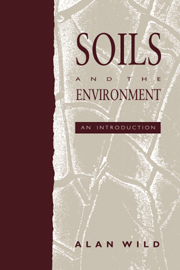Book contents
- Frontmatter
- Contents
- Preface
- Acknowledgements
- Units, symbols and general information
- 1 Introduction: soil in a natural and man-made environment
- A Soil properties and processes
- 2 The soil components
- 3 Development of soils
- 4 Sorptive properties of soils
- 5 Organisms and soil processes
- 6 Movement of water, air, solutes and heat in soil
- B Soils in relation to the environment
- Suggestions for further reading
- Index
2 - The soil components
Published online by Cambridge University Press: 06 January 2010
- Frontmatter
- Contents
- Preface
- Acknowledgements
- Units, symbols and general information
- 1 Introduction: soil in a natural and man-made environment
- A Soil properties and processes
- 2 The soil components
- 3 Development of soils
- 4 Sorptive properties of soils
- 5 Organisms and soil processes
- 6 Movement of water, air, solutes and heat in soil
- B Soils in relation to the environment
- Suggestions for further reading
- Index
Summary
Introduction
Examination by eye of a spadeful of soil may show the following:
aggregates of particles a few millimetres or centimetres in size which, when wet, can be crushed by the fingers;
roots of plants;
pieces of dead roots, stems and leaves, which may be partly decayed; stones and gravel (greater than 2 mm diameter) and sand particles (0.02 to 2 mm diameter);
earthworms and various arthropods, including insects;
spaces between the solid material occupied by air or water or both.
Under an optical microscope smaller particles of silt (0.002 to 0.02 mm diameter) can be observed, and the higher power of an electron microscope will reveal the presence of clay particles (less than 0.002 mm diameter). The dark colour of soil shows the presence of humus. From each spoonful of soil millions of cells of bacteria and other microorganisms can be isolated. If a bottle is half-filled with damp soil and then stoppered, the composition of the air above the soil will change, oxygen being replaced by carbon dioxide due to respiration by soil organisms.
From the above introduction it will be seen that soil contains mineral and organic material, air, water and living organisms. The properties of a particular soil depend largely on the proportion and composition of these components and how they interact with each other. The properties may, however, change because soil is exposed to the weather, plants grow on it and die, it is trampled on by animals, and man cultivates crops on it.
Information
- Type
- Chapter
- Information
- Soils and the Environment , pp. 15 - 36Publisher: Cambridge University PressPrint publication year: 1993
Accessibility standard: Unknown
Why this information is here
This section outlines the accessibility features of this content - including support for screen readers, full keyboard navigation and high-contrast display options. This may not be relevant for you.Accessibility Information
- 1
- Cited by
